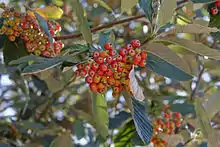Sorbus aria
Sorbus aria (syn. Aria nivea), the whitebeam or common whitebeam,[2] is a European and Near-Eastern deciduous tree, the type species of the subgenus of the whitebeams. Typically compact and domed, with few upswept branches and almost-white underside of the leaves. It generally favours dry limestone and chalk soils. The hermaphrodite cream-white flowers appear in May, are insect pollinated, and go on to produce scarlet berries, which are often eaten by birds.[3] Developed for garden use are the cultivars S. aria 'Lutescens',[4] with very whitish-green early leaves, and S. aria 'Majestica',[5] with large leaves. Both have gained the Royal Horticultural Society's Award of Garden Merit.[6]

Foliage and fruit
| Sorbus aria | |
|---|---|
 | |
| Scientific classification | |
| Kingdom: | Plantae |
| Clade: | Tracheophytes |
| Clade: | Angiosperms |
| Clade: | Eudicots |
| Clade: | Rosids |
| Order: | Rosales |
| Family: | Rosaceae |
| Genus: | Sorbus |
| Subgenus: | Sorbus subg. Aria |
| Species: | S. aria |
| Binomial name | |
| Sorbus aria Crantz | |
 | |
| Distribution map | |
| Synonyms | |
|
Aria nivea Host. | |
References
- Rivers, M.C.; Beech, E. (2017). "Sorbus aria". IUCN Red List of Threatened Species. 2017: e.T62861A112294405. doi:10.2305/IUCN.UK.2017-3.RLTS.T62861A112294405.en.CS1 maint: uses authors parameter (link)
- "BSBI List 2007". Botanical Society of Britain and Ireland. Archived from the original (xls) on 25 January 2015. Retrieved 17 October 2014.
- The Reader's Digest Field Guide to the Trees and Shrubs of Britain p.86.
- "RHS Plant Selector - Sorbus aria 'Lutescens'". Retrieved 4 June 2013.
- "RHS Plant Selector - Sorbus aria 'Majestica'". Retrieved 4 June 2013.
- "AGM Plants - Ornamental" (PDF). Royal Horticultural Society. July 2017. p. 98. Retrieved 13 November 2018.
| Wikimedia Commons has media related to Sorbus aria. |
This article is issued from Wikipedia. The text is licensed under Creative Commons - Attribution - Sharealike. Additional terms may apply for the media files.
